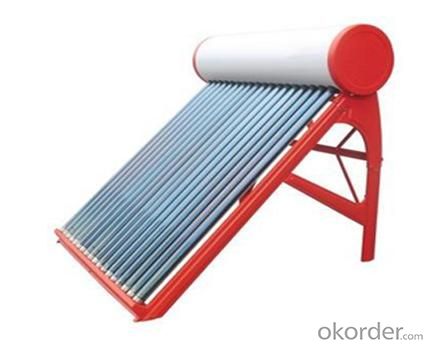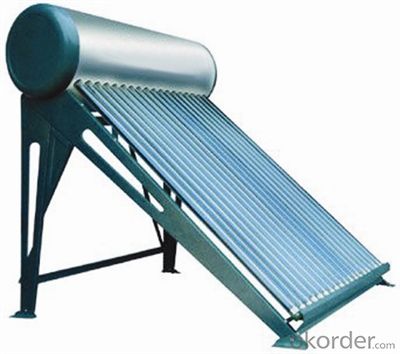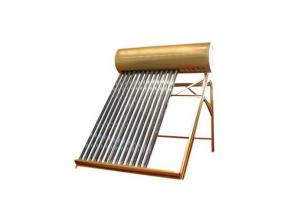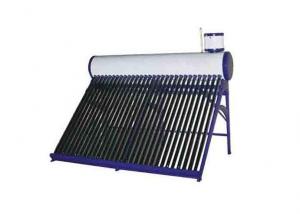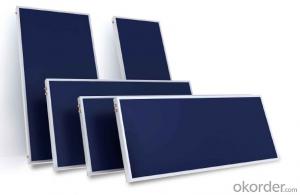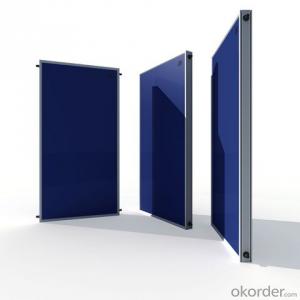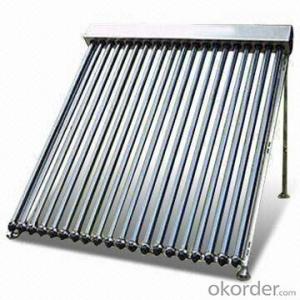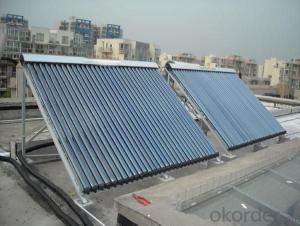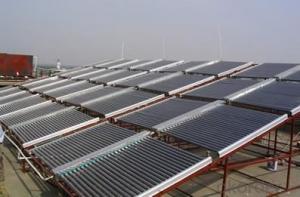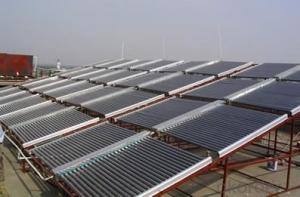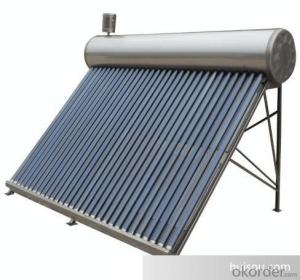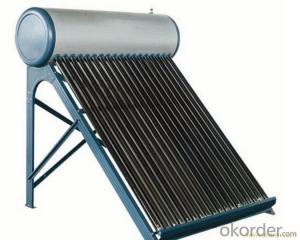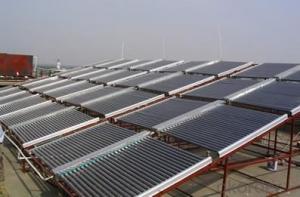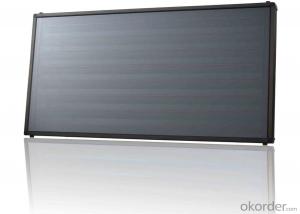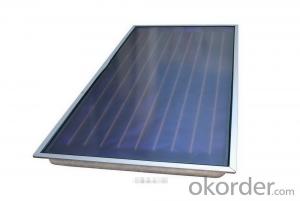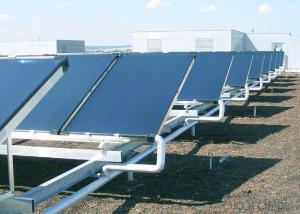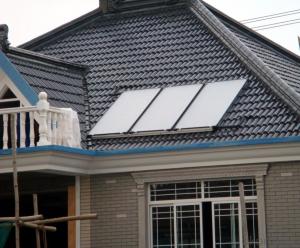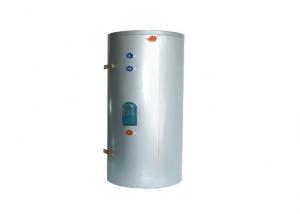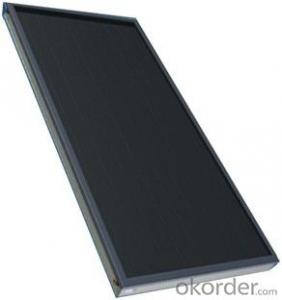2024 New Design Tower Solar Collectors Solar Water Heater System
- Loading Port:
- China main port
- Payment Terms:
- TT OR LC
- Min Order Qty:
- 1 set
- Supply Capability:
- 6000 set/month
OKorder Service Pledge
OKorder Financial Service
You Might Also Like
Introduction of Non-Pressure Solar Water Heater:
Non-pressure Solar Heater is one of the most economical solar water heating device with pretty high efficiency at the same time. It consists of hot water storage tank, solar vacuum tubes with mouth plug in storage tank, and bracket supporting tank and tubes.When cold water in evacuated tubes is heated with solar irradiation, as the specific gravities of hot water and cold water are different, hotter water goes upward to storage tank and colder water goes downward to glass tubes. through this continuous circulation, the cold water in storage tank will be gradually heated till sunset.
Specialty:
1. High thermal performance and working temperature: the heat exchanging rate even in winter can up above 55%.
2. Heat collecting efficiency is at least 20% above common solar systems.
3. Work in all day and all season: no matter any corner of the world, this system can work well even -40℃ to avoid the tube freezing problem.
4. Reliability: No water following through the tube, so water scale can not generate and tube cracks could be avoided, the system still can keep working even with some damaged tubes.
5. It can connect with water tap and work automatically with pressure0.6Mpa, bring enjoyable washing experience.
6. Safety: P/T valve would release pressure and temperature to protect tank..
Technical Specification:
1. Outer tank material: SUS304 stainless steel or powder coated color steel
2. Inner tank material: 1.2mm thick SUS304 food grade stainless steel ( Optional material SUS316L)
3. Vacuum tube material: borosilicate glass 3.3; AL-SS-CU absorb coating, with copper heat pipe inside
4. Frame material: 1.2mm thickness stainless steel
5. Insulation material: 55mm thickness polyurethane
6. Suitable for mains pressure water(up to 8 bar/116psi)
7. Easy plug-in installation
8. Install the T/P valve on the pressurized tank
9. Seal material: Stabilized High Temperature Silicon
Outer tank material: SUS304 stainless steel or powder coated color steel
Inner tank material: 1.2mm thick SUS304 food grade stainless steel ( Optional material SUS316L)
Vacuum tube material: borosilicate glass 3.3; AL-SS-CU absorb coating, with copper heat pipe inside
Frame material: 1.2mm thickness stainless steel
Insulation material: 55mm thickness polyurethane
Suitable for mains pressure water(up to 8 bar/116psi)
Easy plug-in installation
Install the T/P valve on the pressurized tank
Seal material: Stabilized High Temperature Silicon
19. Vacuum Tube | 20. Size (mm) | 21. Φ47*1500 / Φ58*1800 / Φ70*2100 | |||||
22. Tube (pcs) | 23. 10 / 12 / 15 / 18 / 20 / 22 / 24 / 30 / 36 / 42 | ||||||
24. Material | 25. Borosilicate 3.3 glass, magnetron spluttering selective coating | ||||||
26. Coating | 27. Single-target AL-N/AL or Three-target AL/N-Cu-SS | ||||||
28. Water Tank | 29. Capacity | 30. 80L ~ 500L for hot water storage tank | |||||
31. Inner tank | 32. Food-grade stainless steel SUS304-2B / SUS316 | ||||||
33. Insulation | 34. High-density polyurethane foam with 70~80 hour heat preservation | ||||||
35. Tank shell | 36. Food-grade stainless steel SUS304-2B | ||||||
37. Bracket | 38. Shaped strong aluminum alloy structure adaptable for flat or slope roof | ||||||
39. Accessories | 40. Anti-aging silicon seals, Dustproof seals, Air-vent cap, Stainless screws | ||||||
41. Auxiliary Devices | 42. Assistant tank, Intelligent controller, Electrical heater, Magnesium anodes | ||||||
43. Tilt Angle | 44. 25 ~ 50° | ||||||
45. Water Output | 46. 45 - 95°C | ||||||
47. Hail Resistance | 48. Φ25mm diameter | ||||||
49. Model Number | 50. Solar Vacuum Tube | 51. Tank 52. Liter | 53. System 54. Liter | 55. Container Loading Qty /sets | |||
56. Size /mm | 57. Qty /pcs | 58. 20GP | 59. 40GP | 60. 40HQ | |||
61. VNS-58SA12-100 | 62. Φ58*1800 | 63. 12 | 64. 100 | 65. 132 | 66. 58 | 67. 119 | 68. 140 |
69. VNS-58SA15-130 | 70. 15 | 71. 130 | 72. 170 | 73. 54 | 74. 108 | 75. 131 | |
76. VNS-58SA18-150 | 77. 18 | 78. 150 | 79. 198 | 80. 43 | 81. 86 | 82. 105 | |
83. VNS-58SA20-170 | 84. 20 | 85. 170 | 86. 223 | 87. 40 | 88. 80 | 89. 97 | |
VNS-58SA24-200 | 24 | 200 | 263 | 35 | 70 | 85 | |
VNS-58SA30-250 | 30 | 250 | 329 | 28 | 56 | 68 | |
VNS-58SA36-300 | 36 | 300 | 395 | 23 | 47 | 57 | |
Product Show
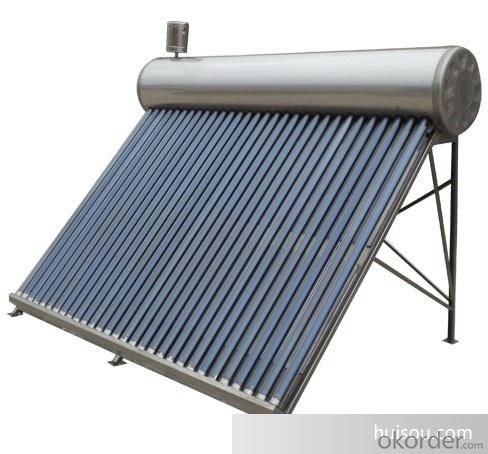
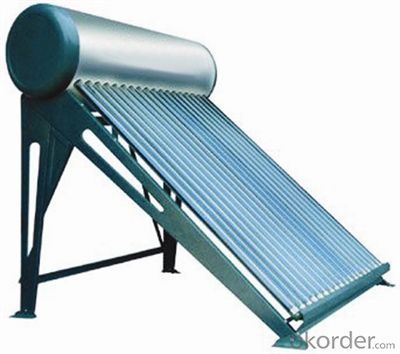
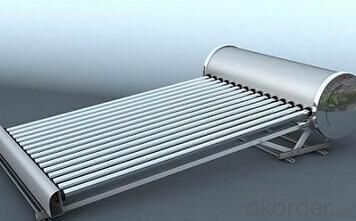
Our Services
1. OEM service
2. Warranty: 5 years
3. Considerable after sale service
Color steel Compact pressure Thermal solar heater
FAQ:
1. What’s the delivery time?
10 days after receiving deposit.
2. How long is the warranty?
5 years for whole system, 1 year for accessory
3. What’s your production capacity?
6000sets/month
4. What’s the MOQ?
1 set.
5. What’s your payment term?
Container: 30% T/T in advance for deposit, 70% T/T before shipment for fist order.
70% T/T after seeing copy of B/L from second order
Sample: 100% T/T in advance
Other choices: L/C at sight.
6. What certifications do you have?
CE, SOLAR KEYMARK, SRCC and etc.
- Q: Flat solar collector how, flat solar collector working principle introduced
- pipe installation, not in the structure of the beam column, the seismic wall of the dark column, the end of the pier at the tube. Through the roof, the wall should be timely embedded casing, to avoid the waterproof insulation has been done on the roof hole
- Q: Can solar collectors be used for heating water in homes?
- Yes, solar collectors can be used for heating water in homes. Solar water heating systems use solar collectors, also known as solar thermal panels or solar water heaters, to capture the sun's energy and convert it into heat. These collectors are usually installed on the roof or in an open area where they can receive maximum sunlight exposure. The collectors contain tubes through which a heat transfer fluid, such as water or antifreeze, circulates. As the sun's rays hit the collectors, the fluid inside absorbs the heat, which is then transferred to a storage tank or directly to the home's water supply. This heated water can be used for various domestic purposes, including bathing, washing dishes, and doing laundry. Solar water heating systems are an environmentally friendly and cost-effective alternative to traditional water heating methods, as they reduce the reliance on fossil fuels and can significantly lower energy bills.
- Q: Can solar collectors be used for industrial purposes?
- Yes, solar collectors can be used for industrial purposes. They can provide an efficient and sustainable source of energy for various industrial processes such as heating, cooling, and powering machinery. Solar thermal collectors can effectively harness the sun's energy and convert it into heat, which can be utilized in industrial applications. Additionally, photovoltaic solar collectors can generate electricity that can be used in various industrial operations. The use of solar collectors in industries contributes to reducing reliance on traditional fossil fuel-based energy sources and helps in achieving sustainability goals.
- Q: Can solar collectors be used for generating electricity on factories?
- Yes, solar collectors can definitely be used for generating electricity on factories. Solar collectors, also known as solar panels or photovoltaic (PV) panels, convert sunlight into electricity through the photovoltaic effect. This means that when sunlight hits the solar panels, it excites the electrons in the panel’s semiconductor material, generating an electric current. Factories typically have large rooftops or open spaces that can be utilized to install solar collectors. These solar panels can be connected to the factory's electrical system, allowing the generated electricity to be used directly in the factory's operations. By using solar collectors to generate electricity, factories can reduce their dependence on traditional energy sources like fossil fuels, thereby reducing their carbon footprint and energy costs. Moreover, solar collectors can also be combined with energy storage systems to store excess electricity generated during the day for use during non-sunlight hours. This enables factories to have a consistent and reliable source of electricity, even during nighttime or cloudy days. In addition to the environmental benefits, utilizing solar collectors for electricity generation can also bring financial advantages to factories. Many countries offer various incentives, such as tax credits, grants, or feed-in tariffs, to encourage the adoption of renewable energy technologies. These incentives can help offset the initial installation costs and provide a return on investment over time. Overall, solar collectors are a viable and sustainable option for generating electricity on factories. They offer a clean and renewable energy source, reduce carbon emissions, and can provide financial benefits. By embracing solar technology, factories can contribute to a greener future while also improving their own energy efficiency and cost-effectiveness.
- Q: Can solar collectors be used for heating arenas?
- Yes, solar collectors can be used for heating arenas. Solar thermal systems can capture and store solar energy, converting it into heat that can be used for various purposes, including heating large spaces like arenas. By installing solar collectors on the arena's roof or nearby, the collected heat can be used to warm up the space, reducing the reliance on traditional heating systems and decreasing energy costs.
- Q: How much do solar collectors cost?
- The cost of solar collectors can vary depending on factors such as size, type, and installation requirements. On average, residential solar collectors can range from $2,000 to $10,000, while larger commercial or industrial systems can cost tens or even hundreds of thousands of dollars. It is recommended to obtain quotes from reputable suppliers or consult with solar professionals for accurate pricing information based on specific needs and location.
- Q: Can solar collectors be used in fuel cell power plants?
- Solar collectors, like solar panels or solar thermal systems, have the capability to be employed in fuel cell power plants. These collectors enable the extraction of energy from the sun and its conversion into electricity or heat. Within a fuel cell power plant, solar collectors can be utilized to generate the necessary electricity for the electrolysis process, which is accountable for the division of water into hydrogen and oxygen. Subsequently, the produced hydrogen can serve as a fuel for fuel cells, which generate electricity via a chemical reaction between hydrogen and oxygen. Through the utilization of solar collectors, fuel cell power plants can effectively harness a renewable energy source to produce hydrogen, thereby enhancing the overall sustainability and environmental friendliness of the process.
- Q: How do solar collectors handle temperature fluctuations?
- Solar collectors are designed to handle temperature fluctuations by using materials and components that can withstand high temperatures. They are typically made with durable materials such as tempered glass or metal that can handle extreme heat without warping or breaking. Additionally, solar collectors often incorporate insulation to help minimize heat loss during colder temperatures. Overall, these design features enable solar collectors to effectively capture and convert sunlight into usable energy regardless of temperature fluctuations.
- Q: Can solar collectors be used in areas with frequent power outages?
- Yes, solar collectors can be used in areas with frequent power outages. Solar collectors generate electricity by converting sunlight into usable energy, which means they can continue to provide power even when the grid goes down. This makes them a reliable and sustainable solution for areas that experience frequent power outages, offering a consistent source of electricity to meet the energy needs of the community.
- Q: How long do solar collectors typically last?
- Solar collectors typically last around 25 to 30 years, but with proper maintenance and care, they can potentially have a longer lifespan.
Send your message to us
2024 New Design Tower Solar Collectors Solar Water Heater System
- Loading Port:
- China main port
- Payment Terms:
- TT OR LC
- Min Order Qty:
- 1 set
- Supply Capability:
- 6000 set/month
OKorder Service Pledge
OKorder Financial Service
Similar products
Hot products
Hot Searches
Related keywords









